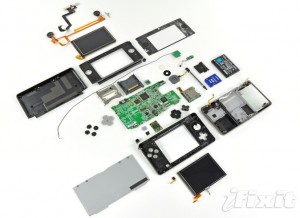Dear Reader:
iFixit teardown - 3DS
* The 3DS’ top display produces 3D images through the use of parallax. A layer in the top LCD responds to adjustments in the 3D slider and changes the image slightly between each of the viewer’s eyes. When it is viewed from the recommended distance, the image appears to be 3D.
* Nintendo is no stranger to 3D gaming, considering its past experience with the ridiculously cool and underrated Virtual Boy. That device used slightly different means to achieve a similar 3D effect.
* The 3D view *should* work for most people, but one iFixit employee (out of about 10 that tried it) had trouble viewing it. To him the screen looked different, but not 3D.
* Unlike previous DS consoles, the entire back cover of the 3DS comes off as one piece rather than having a small door to access the battery. This makes for a cleaner look, but also means that replacing the battery will take a little longer.
* The 3.7V, 1300mAh, 5Wh Li-Ion battery provides a measly 3-5 hours of battery life. Even when playing original DS games, the 3DS lasts only 5-8 hours on a single charge. The battery life is most likely diminished by the reported faster processor, dual LCD elements in the top display (to control the parallax effect), and more hardware intensive programs.
* With the short battery life in mind, Nintendo ships the 3DS with a charging cradle for convenient charging. According to them, a full charge takes 3.5 hours.
* We found an interesting little feature of the 3DS by accident while blowing away some dust with canned air: external mics on the 3DS pick up the characteristic noise of wind blowing by the device and spin the live icons in the background of each menu as if they were in a tornado.
* Nobody is really certain what the infrared port on the 3DS will do just yet, but we’re thinking it’s for some 3DS to 3DS line-of-sight communication. The IR controller IC is manufactured by NXP and has the markings: S750 0803 TSD031C
* The digitizer on the bottom display is much thicker than those found on most cellphones, most likely due to the fact that the touch display is used with a stylus, rather than a fingertip.
* Whereas older versions of the DS had four rubber screw covers on the front display bezel, Nintendo opted for a sleeker approach for their new system by adhering a front panel to the bezel to hide the screws.
* We had to call forth the use of a heat gun and a plastic opening tool in order to gain access to the upper display screws.
* All three cameras are connected together via one ribbon cable. We’re finding this to be a trend amongst the smaller multiple-camera devices, and it makes sense — the info needs to go to the same place to be processed.
* It’s official — this is the most camera-laden device we’ve ever taken apart.
* Chip winners include:
* Nintendo 1048 0H ARM CPU
* Fujitsu MB82M8080-07L
* Toshiba THGBM2G3P1FBAI8 NAND Flash
* Texas Instruments PAIC3010B 0AA37DW
* Invensense ITG-3270 MEMS Gyroscope
